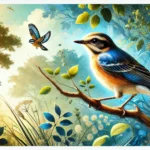The natural world is full of astonishing creatures, and birds are some of the most fascinating. From colorful feathers to peculiar beaks, the avian world offers a wide range of oddities that seem to defy expectations. Across the globe, birds have evolved in ways that leave us scratching our heads, wondering how such strange creatures could possibly exist. These weird birds have adapted unique features for survival, mating, or navigation through their specific environments. Here, we will take a journey into the weirdest birds you won’t believe are real.
10 Weirdest Birds
The natural world is full of astonishing creatures, and birds are some of the most fascinating. From colorful feathers to peculiar beaks, the avian world offers a wide range of oddities that seem to defy expectations. Across the globe, birds have evolved in ways that leave us scratching our heads, wondering how such strange creatures could possibly exist. These weird birds have adapted unique features for survival, mating, or navigation through their specific environments. Here, we will take a journey into the weirdest birds you won’t believe are real.
1. The Shoebill Stork
The Shoebill stork (Balaeniceps rex) looks like something straight out of a prehistoric era. Known for its massive, shoe-shaped beak, this bird can grow up to five feet tall and is native to the swamps and wetlands of Central and East Africa. The shoebill’s powerful beak is not only visually striking but also highly functional, allowing the bird to capture large prey such as lungfish, frogs, and even small crocodiles.
What makes the shoebill especially eerie is its motionless hunting style. It stands completely still, waiting patiently for prey, and then strikes with speed and precision. Despite its large, intimidating appearance, the shoebill is known for being rather quiet, producing low, bill-clattering sounds rather than traditional bird calls.
Why It’s Weird:
- Massive, shoe-shaped beak
- Eerily silent and motionless hunting technique
- Ability to hunt large prey, including young crocodiles
2. The Kakapo
The Kakapo (Strigops habroptilus), also known as the owl parrot, is a flightless, nocturnal parrot native to New Zealand. What makes the kakapo so unique, aside from its large, rotund body and owl-like face, is that it is the world’s heaviest parrot and one of the longest-living birds, with a lifespan of up to 90 years.
Kakapos are also unusual because of their peculiar mating ritual. During breeding season, male kakapos create “booming” sounds to attract females, a low-frequency call that can be heard up to three miles away. Unfortunately, the kakapo is critically endangered, with only about 250 individuals left in the wild due to habitat loss and introduced predators.
Why It’s Weird:
- The heaviest parrot and one of the longest-living birds
- Flightless and nocturnal, unlike most parrots
- Unusual booming mating calls
3. The Andean Cock-of-the-Rock
The Andean Cock-of-the-Rock (Rupicola peruvianus) is a striking bird found in the cloud forests of South America, especially in Peru and Colombia. Known for its vibrant orange or red plumage and large, fan-shaped crest, this bird looks as though it was designed by a modern artist. Its name comes from its habitat, often nesting among rocky cliffs and outcrops.
The cock-of-the-rock is known for its elaborate courtship displays, where males gather in “leks” to show off their bright feathers and perform strange dances to impress females. Their bright colors and odd behaviors make them one of the most visually peculiar birds in the world.
Why It’s Weird:
- Bright orange or red feathers with a fan-shaped crest
- Elaborate courtship displays and communal dancing
- Nesting habits in rocky environments
4. The Secretary Bird
At first glance, the Secretary Bird (Sagittarius serpentarius) might look like an elegant crane or stork, but its hunting style is what sets it apart. Native to the savannas and grasslands of sub-Saharan Africa, this tall bird with long legs is a skilled predator that hunts snakes, lizards, and small mammals by stomping them with its powerful legs.
Its unusual name comes from the black quill-like feathers on its head, resembling the quill pens once used by secretaries in the 18th century. The secretary bird’s odd combination of elegance and brutality makes it a truly weird member of the avian world.
Why It’s Weird:
- Long legs for stomping prey, especially snakes
- Distinctive black feathers resembling quill pens
- Predatory bird with a unique hunting style
5. The Hoatzin
The Hoatzin (Opisthocomus hoazin) is a bird that seems to break all the rules of avian biology. Found in the Amazon rainforest, the hoatzin is sometimes called the “stinkbird” because of its strong odor, which results from its unique digestive system. Unlike most birds, the hoatzin relies on bacterial fermentation in its crop to break down its plant-based diet, similar to how cows digest food.
In addition to its unusual digestive system, young hoatzins have claws on their wings, reminiscent of ancient birds like Archaeopteryx. This feature allows the chicks to climb trees before they can fly.
Why It’s Weird:
- Unique digestive system that ferments plant matter
- Strong odor due to fermentation, earning the name “stinkbird”
- Chicks have clawed wings, a primitive trait not found in most modern birds
6. The Great Potoo
The Great Potoo (Nyctibius grandis) is a master of camouflage and one of the most peculiar-looking nocturnal birds. Native to Central and South America, this bird spends the day perched motionless on tree branches, blending perfectly with its surroundings thanks to its mottled gray and brown feathers. At night, it becomes an active predator, hunting insects and small vertebrates.
The potoo’s large, gaping mouth is designed for catching prey, but it also gives the bird an odd, almost ghost-like appearance. Its haunting call, which sounds like a mournful moan, adds to the eerie aura surrounding this bird.
Why It’s Weird:
- Expert in camouflage, resembling a tree branch
- Large mouth and wide eyes give it an eerie appearance
- Strange, mournful calls that can be heard at night
7. The Vulturine Guineafowl
The Vulturine Guineafowl (Acryllium vulturinum) is a striking bird that looks like a cross between a vulture and a guineafowl. Found in East Africa, this bird has an unmistakable appearance, with a bald head, long neck, and glossy blue, black, and white plumage. Unlike other guineafowls, the vulturine guineafowl has a more elegant and vulture-like build, giving it a strange and exotic look.
This bird is highly social, often found in large flocks, and it has a peculiar habit of roosting in trees despite being a ground-dwelling bird.
Why It’s Weird:
- Bald head and long neck, resembling a vulture
- Striking blue, black, and white feathers
- Social behavior, often found in large flocks
8. The Long-Wattled Umbrellabird
The Long-Wattled Umbrellabird (Cephalopterus penduliger) is native to the rainforests of Ecuador and Colombia and is one of the most bizarre-looking birds in the world. This bird gets its name from the large, umbrella-like crest on its head and the long wattle (a fleshy, feathered appendage) hanging from its chest.
The wattle is used in courtship displays, and during mating season, males inflate the wattle and produce low-pitched calls to attract females. Its unusual appearance and behavior make the umbrellabird one of the most intriguing birds in South America.
Why It’s Weird:
- Large, umbrella-like crest and long feathered wattle
- Unique mating calls and display behaviors
- Rare and difficult to spot in the wild
9. The Blue-Footed Booby
The Blue-Footed Booby (Sula nebouxii) is a seabird found along the coasts of the Pacific Ocean, most famously in the Galápagos Islands. Its most noticeable feature is its bright blue feet, which are used in elaborate courtship dances. Males show off their feet by lifting them in a high-stepping dance to attract females.
Despite its comical appearance, the blue-footed booby is a skilled hunter, diving into the ocean from great heights to catch fish.
Why It’s Weird:
- Bright blue feet, which are used in mating displays
- Comical courtship dances to attract mates
- Skilled at diving for fish from significant heights
10. The Philippine Eagle
The Philippine Eagle (Pithecophaga jefferyi), also known as the “monkey-eating eagle,” is one of the largest and most powerful eagles in the world. Endemic to the Philippines, this bird has a striking appearance, with a shaggy crest of feathers around its head and sharp talons for catching prey.
What makes the Philippine eagle particularly weird is its diet, which includes monkeys, snakes, and even monitor lizards. Sadly, the species is critically endangered due to habitat loss and hunting.
Why It’s Weird:
- Shaggy crest and large, powerful build
- Known for hunting monkeys, a rare trait among birds of prey
- Critically endangered, with a small population remaining in the wild
Conclusion
The avian world is full of wonders, and these ten birds prove that nature’s creativity knows no bounds. From the shoebill’s prehistoric appearance to the kakapo’s flightless nocturnal habits, each of these birds has evolved unique traits that make them stand outand often seem like they come from a different world. Whether it’s the shoebill’s giant beak, the kakapo’s inability to fly, or the Philippine eagle’s striking predatory skills, these birds demonstrate the fascinating diversity of life on Earth. Each one has adapted to its unique environment in ways that challenge our understanding of bird behavior and biology.
The next time you think of birds as just pigeons or robins, remember these extraordinary creatures, each with its own weird and wonderful traits. Exploring the avian world can lead to incredible discoveries and a greater appreciation for the rich variety of life that exists around us.
FAQs
What makes the shoebill stork so unique?
The shoebill stork is known for its massive, shoe-shaped beak, which it uses to catch large prey such as lungfish and small crocodiles. It also has an eerie hunting technique where it stands motionless for long periods before striking its prey.
Why is the kakapo critically endangered?
The kakapo is critically endangered due to habitat destruction and the introduction of predators like rats and cats to its native New Zealand. Conservation efforts are ongoing to save the remaining kakapo population.
How do blue-footed boobies use their feet in courtship?
Male blue-footed boobies use their bright blue feet in elaborate courtship dances, lifting them in a high-stepping motion to attract females. The brighter the blue, the more attractive the male is to potential mates.
Can the Philippine eagle really hunt monkeys?
Yes, the Philippine eagle is known for hunting monkeys, among other prey such as snakes and monitor lizards. Its large size and powerful talons make it one of the most formidable birds of prey.
What is the diet of the hoatzin?
The hoatzin primarily eats leaves and other plant material, which it digests using bacterial fermentation in its crop, much like a cow’s digestive system. This unusual diet and digestive process give the hoatzin its nickname, “the stinkbird.”


